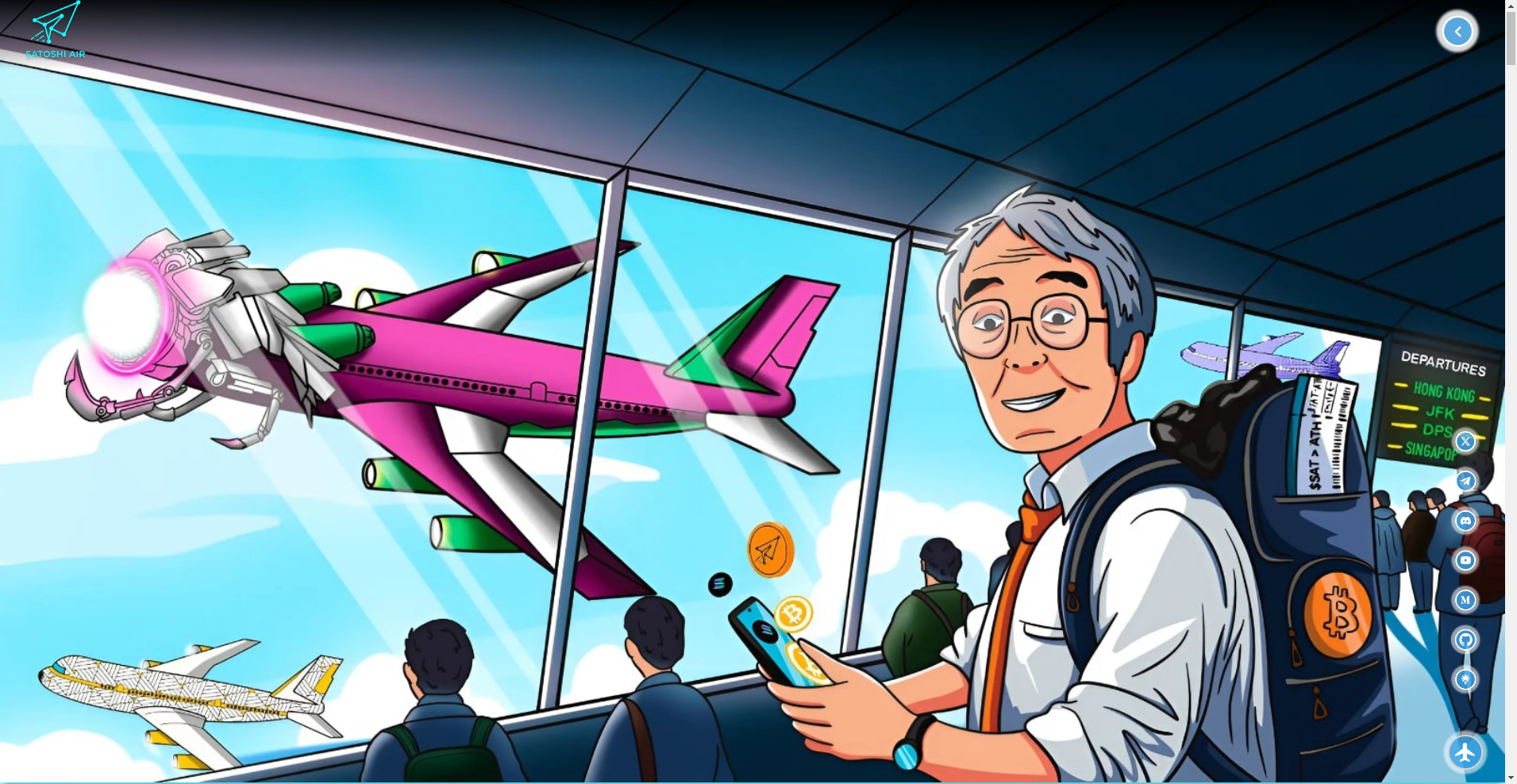Satoshi Airline ($SAST) Review: A Data-Driven Look at Its Legitimacy, Technology, and Risks

What Is Satoshi Airline: An Introduction
Satoshi Airline presents itself as a "Fly to Earn" travel platform incorporating blockchain technology, GameFi, and NFT-based loyalty elements. Built on Polygon, its core concept revolves around rewarding users with cryptocurrency tokens for flying, thereby transforming traditional travel reward systems into decentralized, flexible financial instruments. The project promotes an immersive travel experience that merges gaming, NFTs, and DeFi, aiming to create a comprehensive ecosystem for crypto enthusiasts and travelers alike. The integration of NFT-based loyalty elements aims to enhance user engagement and offer unique rewards within its ecosystem.
This review provides an impartial analysis of Satoshi Airline, examining its technological infrastructure, team credentials, security posture, tokenomics, ecosystem activity, and legal considerations. The goal is to assess its legitimacy and potential risks for investors and users, grounded solely on available data and audit reports, with an emphasis on understanding the projects within the Polygon ecosystem.
The Team and Vision Behind Satoshi Airline
The project boasts a team comprising both industry veterans and technically skilled professionals. Notable members include:
- Muzammil Ramzan: CTO, with a background in blockchain solutions and business innovation, and CEO Mian Zahid, experienced in blockchain architecture and full-stack development.
- Diana Richi: Lead UI/UX designer, specializing in NFTs and digital art.
- Moh Nur Bimantoro: CEO with a background in travel and crypto, reinforcing the project's travel-centric vision.
- Development and Community Managers: Including Tanveer Jafri (DEV) and Mohammad Wafi (Community Manager), indicating an emphasis on technical delivery and community engagement.
While many team members have accessible professional backgrounds, there is limited evidence of widespread public scrutiny or prior successful project launches. This can impact perceptions of credibility, especially given the complex intersection of travel, gaming, and DeFi they aim to integrate.
Regarding the roadmap, specific milestone details are sparse, but the project emphasizes partnerships with social, GameFi, and travel domains, aiming for continuous feature expansion. The presence of a well-defined road map is promising; however, execution credibility depends on their ability to meet outlined deliverables within set timelines.
Assessing the Security and Integrity of Satoshi Airline
The security evaluation stems from Cyberscope's recent audit report, which primarily assessed the token smart contract deployed on Polygon (formerly MATIC). This is a critical step, as security vulnerabilities in smart contracts can lead to substantial financial losses and undermine investor trust. Understanding Cyberscope's audit reports is crucial for assessing project security.
Based on the Cyberscope audit, the key findings include:
- Audit status: Successfully completed, with the report indicating a focus on token contract security.
- Critical vulnerabilities: The audit identified high-criticality issues, which were marked as "High Criticality" and addressed during the audit iteration. The specifics of vulnerabilities are not publicly detailed, but their presence warrants caution.
- Security score: An estimated 90/100 score, placing it in a high-confidence category, though not perfect.
- Decentralization: Score of 57/100, implying moderate centralization control, which could affect resilience against governance or security exploits.
- Audit completeness: The iterative process and final review suggest active bug patching, but residual risks may remain due to the complex nature of DeFi security.
While a high security score and thorough audit are positive signals, the identified vulnerabilities—particularly the high-criticality ones—pose potential risks. Investors should remain vigilant, recognizing that smart contract security is paramount in DeFi projects. The absence of multiple independent audits further emphasizes the need for cautious engagement.
A Breakdown of Satoshi Airline Tokenomics
The tokenomics underpinning Satoshi Airline involve the JET token, which plays a central role in its ecosystem. The distribution model and issuance schedule reveal the project's economic sustainability and potential inflationary/deflationary pressures. This aligns with the broader concept of "Fly to Earn" models in blockchain.
- Total Supply: 500 million JET tokens, serving as the primary utility and governance token.
- Initial Market Cap: Roughly $772,500, indicating a modest launch valuation.
- Fully Diluted Valuation (FDV): Approximately $25 million, reflecting projected future market cap assuming full token circulation.
- Distribution & Vesting:
- Team: 10% (18-month cliff, 24-month vesting)
- Marketing: 5% (20-month linear vesting)
- Travel To Earn: 30% (6-month cliff, 48-month vesting)
- Ecosystem & Treasury: 25% (13-month cliff, 39-month vesting)
- Liquidity: 10% (18-month linear vesting)
- Advisors: 3% (18-month cliff, 24-month vesting)
- Airdrop: 2% (12-month linear)
- Pre-Seed: 4% (10-month cliff, 22-month vesting)
- Seed: 5% (8-month cliff, 18-month vesting)
- Private: 4% (6-month cliff, 10-month vesting)
- Public: 2% (6-month linear)
- Token utility: Used for flying rewards, NFTs, staking, and ecosystem participation.
This distribution promotes long-term staking and ecosystem growth but poses risks typical of projects with significant team and pre-allocations, such as potential sell-offs post-vesting. The inflationary model could dilute value unless demand aligns with supply growth, which is uncertain given current adoption levels.
Assessing Satoshi Airline's Development and Ecosystem Activity
Development progress is evidenced by ongoing smart contract audits, a functional token, and an active Discord community with over 9,200 members. The audit iterations, combined with active social channels, suggest that the team maintains momentum and is transparent about their progress.
The project emphasizes engaging features such as NFT minting, staking, and a storyline-driven gameplay experience, indicating a focus on user retention and ecosystem expansion. However, publicly available activity reports from GitHub or detailed project milestones are limited, making it challenging to verify the depth of ongoing development beyond proxy signals like audit reports and community activity.
Moreover, the presence of a gamified storyline and integration with AI travel bots hint at a strategic vision aiming for high user engagement. Still, actual usage data and transaction volumes remain modest, implying that user adoption is still in nascent stages.
The Fine Print: Analyzing Satoshi Airline's Legal & Community Terms
Available documentation suggests a conventional legal framework with no overt red flags, such as invalid clauses or undisclosed obligations. The project’s terms do not specify restrictions on token transfers or developer control that would alarm seasoned investors.
Some potential concerns include:
- Possible vagueness in the scope of the "NFT Loyalty Program" and how secondary sales could impact token utility and rewards.
- Relatively moderate decentralization scores (57/100), indicating centralized control over governance or protocol parameters.
- Limited disclosure about the legal status of user funds stored in NFTs or liquidity pools, which warrants careful review before large investments.
Overall, the legal terms do not appear to contain overtly risky clauses, but investors should remain aware that the project is still evolving and that contractual protections typical of mature platforms may not be fully in place.
Final Analysis: The Investment Case for Satoshi Airline
Satoshi Airline presents a compelling concept by intertwining travel, gaming, and DeFi through an innovative "Fly to Earn" model. Its strategic use of NFTs, staking, and community engagement indicates a project aiming for multi-layered utility and long-term ecosystem growth. The security posture, bolstered by a recent audit, suggests a reasonable level of technological diligence, although residual vulnerabilities warrant caution.
Nevertheless, several core risks temper its potential. The moderate decentralization score hints at control concentration, and the relatively modest active user metrics imply adoption still needs significant traction. The tokenomics, while balanced, could face inflationary pressures without measurable demand growth. Also, the project’s extensive roadmap knowledge is limited, which clouds clarity on deliverable timelines.
-
Pros / Strengths
- Innovative blend of travel, NFT, and DeFi elements creating a unique ecosystem.
- Recent security audit with high scores, addressing high-critical vulnerabilities.
- Active community with over 9,200 Discord members and substantial Twitter following.
- Clear token utility combining rewards, staking, and NFTs, with a detailed vesting schedule.
-
Cons / Risks
- Limited independent external audits beyond Cyberscope’s report.
- Moderate decentralization score, potential governance risks.
- Adoption is nascent; transaction volumes are still low.
- Potential inflationary pressures and sell-offs based on token vesting schedules.
- Developments and milestones lack detailed public timelines, casting some doubt on delivery capabilities.
In conclusion, Satoshi Airline exhibits promising innovation and strategic planning but remains in early stages with inherent risks typical of nascent blockchain projects. Prospective investors or users should weigh the innovative features against these risks and conduct their due diligence before deep engagement, recognizing that the project's long-term success will depend on execution, security, and community adoption.
